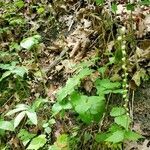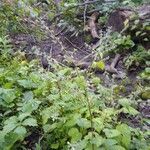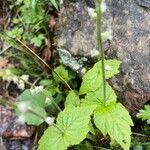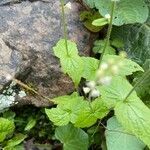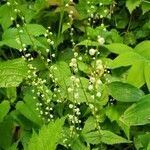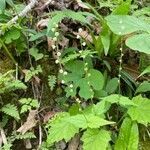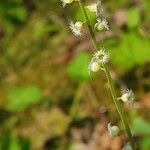Plants not stoloniferous. Flowering stems 10-45(-51) cm. Leaves: petiole 1.8-18 cm, medium and long stipitate-glandular, longer hairs retrorse, white or tan; blade ovate to broadly ovate, n as long as or longer than wide, 1.4-8.5 × 1.4-9.6 cm, margins shallowly to prominently 3-or 5-lobed, crenate or dentate, irregularly to regularly ciliate, apex of terminal lobe acute, rarely obtuse, surfaces subglabrous or sparsely short and long stipitate-glandular; cauline leaves 2, mid cauline or distal, opposite or subopposite, subsessile to short-petiolate, blade (1.1-)1.6-8 × 0.7-6.5 cm. Inflorescences 1-5, remotely or closely 5-22(-27)-flowered, 1 flower per node, not secund, 10-45(-51) cm, sparsely to densely spreading or retrorsely long stipitate-glandular proximally, short stipitate-glandular distally. Pedicels 1-3 mm, short stipitate-glandular. Flowers: hypanthium broadly campanulate, 1-1.6 × 2-3.4 mm; sepals spreading, greenish white or yellowish green, triangular, 1-1.3 × 0.8-1.1 mm; petals white, 9-11(-15)-lobed, 2-4 mm, lobes linear, lateral lobes spreading or ascending; stamens 10, opposite and alternate with sepals; filaments white, 0.2-0.3 mm; anthers 0.1-0.3 × 0.1-0.2 mm; ovary nearly superior; styles divergent, flattened, 0.1-0.2 mm; stigmas unlobed. Seeds dark reddish brown or blackish, 1.2-1.6 mm, nearly smooth. 2n = 14.
More
Stems 1–4 dm, sparsely hairy below, glandular-puberulent above; basal lvs long-petioled, ovate-rotund with cordate base, shallowly 3–5-lobed, crenate, hairy; cauline lvs 2, mostly sessile, smaller, mostly 3-lobed; raceme 5–15 cm; pedicels 1–2 mm; fls white; pet 2 mm, deeply fimbriate-pinnatifid, with obliquely ascending segments; seeds few, black, shining, 1–1.5 mm; 2n=14. Rich woods; Que. to Minn., s. to Va., Ga., and Mo. May, June. An apparent hybrid with M. nuda is M. ×intermedia Bruhin.
